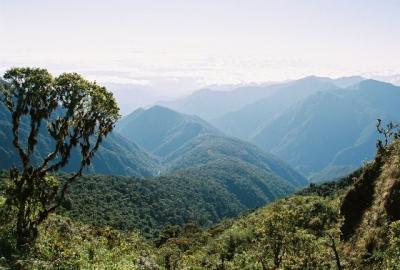Feb 6 2014
For the first time, scientists have discovered how tree roots in the mountains may play an important role in controlling long-term global temperatures.
 This is the valley in the Southern Peruvian Andes where fine root growth and organic layer thickness were measured over several years. Credit: Cecile Girardin
This is the valley in the Southern Peruvian Andes where fine root growth and organic layer thickness were measured over several years. Credit: Cecile Girardin
Researchers from Oxford and Sheffield Universities have found that temperatures affect the thickness of the leaf litter and organic soil layers, as well as the rate at which the tree roots grow. In a warmer world, this means that tree roots are more likely to grow into the mineral layer of the soil, breaking down rock into component parts which will eventually combine with carbon dioxide. This process, called weathering, draws carbon dioxide out of the atmosphere and cools the planet. The researchers say this theory suggests that mountainous ecosystems have acted like the Earth's thermostat, addressing the risk of 'catastrophic' overheating or cooling over millions of years.
In their research paper published online in Geophysical Research Letters, the researchers carried out studies in tropical rain forests in Peru, measuring tree roots across different sites of varying altitude – from the warm Amazonian Lowlands to the cooler mountain ranges of the Andes. They measured the growth of the tree roots to 30 cm beneath the surface, every three months over several years. At each of the sites, they also measured the thickness of the organic layer above the soil. This information was then combined with existing data of monthly temperature, humidity, rainfall, and soil moisture in order to calculate the likely breakdown process of the basalt and granite rocks found in the mountain ranges of Peru.
Using this model, based on field data in Peru, the scientists were able to scale up in order to calculate the likely contribution of mountain forests worldwide to global weathering rates. The researchers then calculated the likely amount of carbon to be pulled out of the atmosphere through weathering when the Earth became very hot. They looked at the volcanic eruptions in India 65 million years ago (known as the Deccan traps). The model also allowed them to calculate the weathering process and carbon feedback after the Earth's cooling 45 million years ago, when great mountain ranges like the Andes and the Himalayas were first formed.
The paper suggests that mountainous regions may play a particularly important role in drawing carbon out of the atmosphere because they have abundant volcanic rock which is highly reactive to weathering when it disintegrates.
Lead researcher Chris Doughty, from the School of Geography and the Environment at the University of Oxford, said: 'This is a simple process driven by tree root growth and the decomposition of organic material. Yet it may contribute to Earth's long-term climate stability. It seems to act like a thermostat, drawing more carbon dioxide out of the atmosphere when it is warm and less when it is cooler.
'A series of climatic events over the last 65 million years ago have resulted in global temperatures rising and falling. However, the weathering process that regulates carbon dioxide in the atmosphere may be buffered by forests that grow in mountainous parts of the world. In the past, this natural process may have prevented the planet from reaching temperatures that are catastrophic for life.'